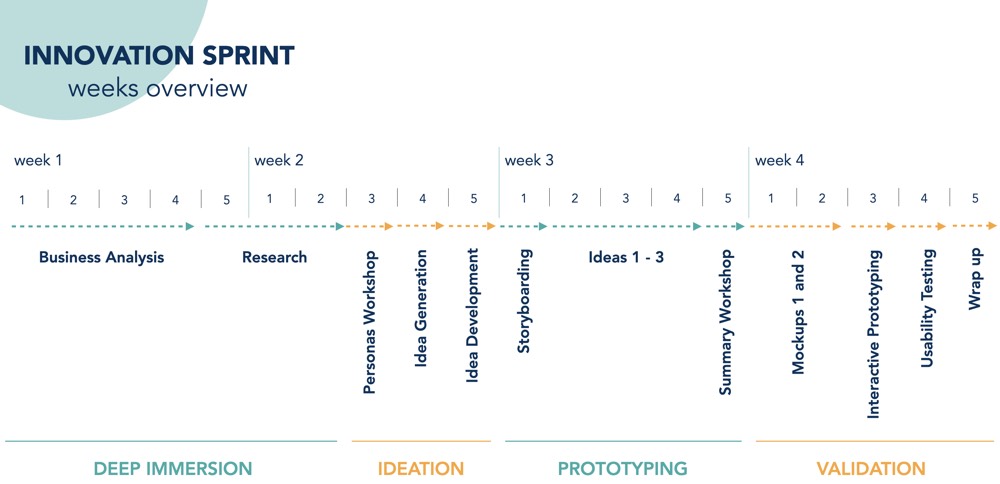
Innovation Sprint — Exploring and validating a business direction in 2 to 4 weeks
October 12, 2021
Organisations who stick to the business-as-usual mindset have a hard time taking the time and effort needed to explore and pursue new ideas that can give them the advantage they need to keep up with competitors or stand out from them.
The solution might be running an Innovation Sprint, a new method created by Xperienz. Simply put, the Sprint team joins efforts with the organisation team and in 2 weeks (minimum) they identify three strategic business directions, taking into account the organisation’s current state and structure. These innovative ideas are prototyped and tested and in the end the organisation will know the best path to follow.
What is an Innovation Sprint?
An Innovation Sprint can range from 2 to 4 weeks (or more). It is conducted by a small multidisciplinary team of researchers and designers who partner with the organisation team.
During that time, the team takes the organisation’s business attributes and identifies opportunities that match market needs. Here’s an example: a delivery company has several cars and makes all clients’ deliveries in the morning. Those cars are completely unused all afternoon. There’s then the opportunity to search for a business that takes advantage of those cars.
Taking an ideation approach, the Sprint team identifies 3 opportunities and validates their logistical feasibility in the company. Then they build validation prototypes to discover which is the more suitable one. This way the company reduces uncertainty and avoids spending money trying to actually set up the operations to validate them, and even if it doesn’t work out, the costs were minimal.
Sprint Weeks Overview
Week 1 — In the first seven days, the Sprint team fully immerses into the organisation, finding out all about the business, the organisational structure, processes, tools, and systems. During that time, they identify organisational problems, challenges and opportunities.
Week 2 — The second week is mainly dedicated to ideation. This is the time to think outside the box, generate ideas and explore many possible solutions.
Week 3 — Three of those ideas are selected and validated through prototyping and testing.
Week 4 — The lessons learned from testing the three ideas result in a final idea, which is validated with an interactive prototype and with real users.

Why should an organisation run an Innovation Sprint?
- Generate groundbreaking ideas for new products, technologies, services and business models;
- Build user value by improving products or create new ones;
- Get actionable data on multiple concepts at a rapid pace;
- Make better investment decisions, evidence-based;
- Ideas are validated with low- and high-fidelity prototypes;
- By testing ideas, the risk of failure is considerably reduced;
- Save time and resources;
- Improve the organisation’s competitive advantage.
What are the mais goals of an Innovation Sprint?
1 — Reduce the uncertainty and the risk in strategic decision-making, contributing to more informed decisions and supported by preliminary evidence.
2 — Quickly gather insights to support decision-making on 3 possible strategic directions through research, design and rapid prototyping for each of the directions.
3 — Select one the 3 directions and carry out an additional interaction validation to the chosen direction, in order to reduce the risk and identify opportunities.
Which resources are involved?

Photo by Dylan Gillis on Unsplash
The Sprint Team — The Innovation Sprint is conducted by a multidisciplinary team in order to ensure that business consulting, research, user research, human-centric design, prototyping and user testing skills are present throughout the process.
The Sprint team is formed by fixed elements who have the support and involvement of different areas of expertise during the sprint weeks. At each time, the team allocated to the Sprint is formed by several elements according to the skills needed in that specific phase of the Sprint.
The Client Team — In order to ensure the sprint goals are met, it’s crucial that members of the company are present in specific moments.
One of the client’s team member should have the authority to make binding decisions about the sprint, so that things can move at a good pace.
Client team members should know the challenges analysed. They should be from different company’s departments and have different profiles.
Innovation reduces uncertainty and speeds up decision-making
Researching all about the organisation and identifying the main issues avoids making strategic business decisions based on assumptions. It helps to define a problem to solve and come up with innovative solutions for it.
Through research and prototype testing the Sprint team can explore the needs and pain-points in loco and gather evidence that will add value to the solution built for users. By developing, improving and strengthening a business idea, organisations will know they are making the right investment and stand out from their competition.
Want to run an Innovation Sprint in your organisation?
Xperienz has a skilled, multidisciplinary team who will deep dive into your organisation and assess its current state, studying systems, tools and processes. Through business consultancy, research, human-centric design, prototyping and user testing, in just few weeks we will identify opportunities and point out the right business direction.
Tell me moreRelated Articles
-
Prompt-based — The birth of a new human-machine interaction model
The ways humans interact with technology has evolved significantly over the decades — and it’s still constantly evolving. The rise of Artificial Intelligence (AI) and natural language processing (NPL) has brought to light a new way of interaction — prompts.
-
A glimpse into the future — Here’s the UX design trends we expect to dominate 2024
Emerging technologies and tools constantly influence the way people use the Internet and interact with digital products. And as user behaviours and preferences evolve, designers must keep up with new tools and solutions to deliver interfaces and user experiences that cater the needs of an ever-demanding audience.
-
How can insurance companies make their digital products more accessible?
Millions of people who live with a disability struggle to access important information online because websites and apps are built with major content and technological barriers. And insurance websites are not an exception.
-
Barrier-free banking - From branches to mobile apps accessible for all
In the banking and financial industry, accessibility is about empowering everyone, including people with disabilities and the elderly, to enjoy bank's products, services and facilities, by making them convenient and easy to use.
-
Design for a better world - How working together and applying design approaches is improving people's lives
9 November is World Usability Day 2023. This year's theme is Collaboration and Cooperation, which intents to focus on how we can work together to create solutions, both globally and locally, to solve the world's biggest problems.
-
Be an Agent of Change - Check these resources to help you build more ethical designs
The role of today's designer goes far beyond simply creating beautiful interfaces and experiences. You can no longer design without considering the consequences of how what you're creating impacts individuals, society and the world.
-
E-commerce and Accessibility - Creating an inclusive online shopping experience
Now it’s the time for online stores to improve their website accessibility and ensure they offer an inclusive experience for everyone.
-
Accessibility Compliance App - by Xperienz. A useful tool when fixing accessibility errors
To simplify the presentation of the accessibility evaluation of websites, Xperienz has created the Accessibility Compliance App. We start by doing a content inventory in which we collect all the pages of the site. Then we evaluate each page and list all the aspects that need to be fixed.
-
What does the UX future hold? - Here's the UX Design trends we expect to dominate 2023
Businesses must stay up to date on emerging user experience and interface trends so we've selected 7 top trends that are already making, and will certainly continue to make, an impact on website and app development.
-
Raising Awareness for Web Accessibility [Infographic] — International Day of Persons with Disabilities
Last December 3 we celebrated the International Day of Persons with Disabilities. To help promote a more accessible Web we’ve put together an easy-to-digest infographic about Web Accessibility.
-
Why hiring external UX services even when you have an in-house UX team?
Even if you have an in-house UX design team, there might be times when additional resources and professional know-how can be useful. Bringing in an external UX team might be exactly what you need for your company to excel in all projects.
-
Innovation Sprint — Exploring and validating a business direction in 2 to 4 weeks
During an Innovation Sprint, a new method created by Xperienz, the Sprint team joins efforts with the organisation team and in 2 weeks (minimum) they identify three strategic business directions, taking into account the organisation’s current state and structure. These innovative ideas are prototyped and tested and in the end the organisation will know the best path to follow.

